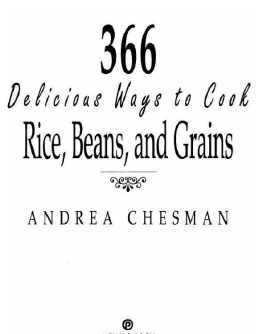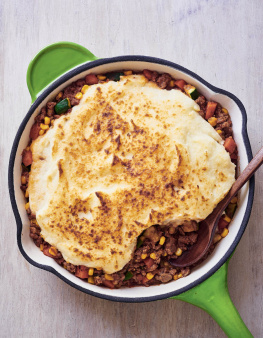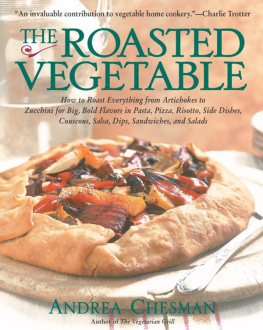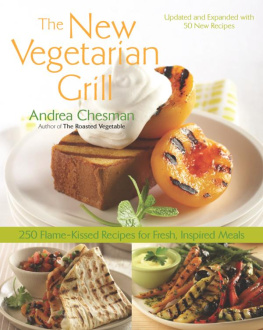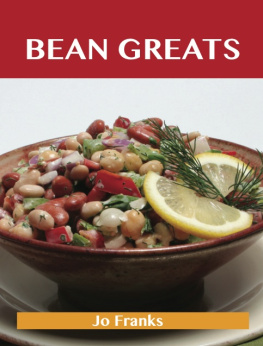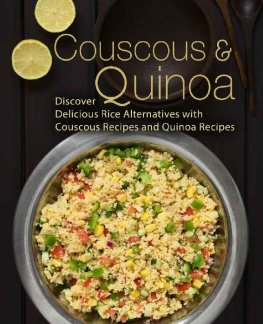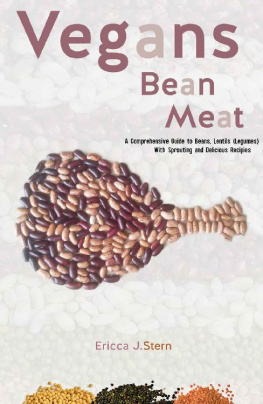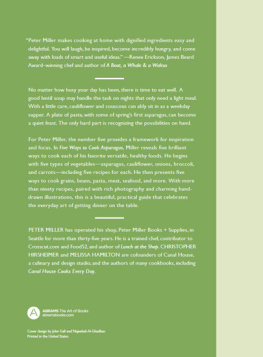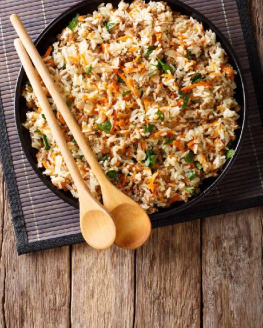Table of Contents
FROM DOWN-HOME SPLIT PEA TO EXOTIC MOONG DAHL SOUP, OLD-FASHIONED JOHNNY CAKES TO LEMON BERRY COUSCOUS CAKE, YOULL LOVE DISCOVERING THE MANY POSSIBILITIES OF RICE, BEANS, AND GRAINS

Andrea Chesman makes it easy to prepare nutritious yet tasty meals featuring some of natures most versatile and healthful foods. All the excitement of ethnic treats such as Risi e Bisi (rice and peas) joins the comfort of old-time favorites like creamy Baked Rice Pudding and hearty Almost Moms Quick Chili. This wonderful new cookbook features:
Mouth-watering low-fat recipesA detailed nutritional analysis of calories, fat grams, percentage of calories from fat, protein, fiber, calcium, and sodium for every dishFlavorful vegetarian recipes along with healthful variations that include salmon, shrimp, and chicken
ANDREA CHESMAN has written several cookbooks, including Salad Suppers, Yankee Church Suppers and Potluck Dinners, Simply Healthful Skillet Suppers, and Simply Healthful Pasta Salads. She lives in Vermont.

PLUME
Published by the Penguin Group
Penguin Putnam Inc., 375 Hudson Street,
New York, New York 10014, U.S.A.
Penguin Books Ltd, 27 Wrights Lane,
London W8 5TZ, England
Penguin Books Australia Ltd Ringwood,
Victoria, Australia
Penguin Books Canada Ltd, 10 Alcorn Avenue,
Toronto, Ontario, Canada M4V 3B2
Penguin Books (N.Z.) Ltd, 182-190 Wairau Road,
Auckland 10, New Zealand
Penguin Books Ltd, Registered Offices: Harmondsworth, Middlesex, England
First published by Plume, an imprint of Dutton Signet, a member of Penguin Putnam Inc.
First Printing, February,
Copyright Andrea Chesman, 1998
All rights reserved

REGISTERED TRADEMARKMARCA REGISTRADA
LIBRARY OF CONGRESS CATALOGING-IN-PUBUCATION DATA:
Chesman, Andrea.
366 delicious ways to cook rice, beans, and grains / Andrea Chesman.
p. cm.
Includes index.
eISBN : 978-1-101-07574-6
1. Cookery (Rice) 2. Cookery (Beans) 3. Cookery (Cereals)
I. Title.
TX809.R5C44 1998
641.81-dc21 97-24289)
CLP
Without limiting the rights under copyright reserved above, no part of this publication may be reproduced, stored in or introduced into a retrieval system, or transmitted, in any form, or by any means (electronic, mechanical, photocopying, recording, or otherwise), without the prior written permission of both the copyright owner and the above publisher of this book.
BOOKS ARE AVAILABLE AT QUANTITY DISCOUNTS WHEN USED TO PROMOTE PRODUCTS OR SERVICES. FOR INFORMATION PLEASE WRITE TO PREMIUM MARKETING DIVISION, PENGUIN PUTNAM INC., 375 HUDSON STREET, NEW YORK, NEW YORK 10014.
http://us.penguingroup.com
To Richard,
a taster of unfailing good cheer and sensitivity.
ACKNOWLEDGMENTS
No one can undertake a work of this many recipes without enlisting the aid of numerous tasters, sharers of recipe ideas, and general supporters. My special thanks go to Richard, Rory, and Sam, who tasted day in and day out for more than a year; my sisters, Linda, Toby, and Debra, who tasted, tested, and commented; regular tasters Su White, Eric Warren, and the potters at Frog Hollow in Middlebury; the helpful folks at the Middlebury Natural Foods Co-op; Cheryl Namy Dickason, who shared her Mujdara recipe and opened my palate to the potential of lentils; M. J. Price, who shared the secret of her marvelous muffins and helped me to walk off the extra calories; Kim Kimler, who faithfully hauled away my overcooked grains and under-seasoned beans to his chickens and graciously returned with fresh eggs; and the many other friends who came to dinners and parties at my house as witting and unwitting taste-testers. Finally, my deep appreciation goes to Doe Coover, who made this and other projects possible.
Introduction

Im not the sort of person who spends time at parties exchanging recipes. But lately I have found myself in the middle of conversations about beans and grains. Everyone wants to cook them more often, but nobody seems to have enough good recipes.
Try this one, I say. Its a Syrian dish called Mujdara (pronounced Jud ruh). Cook up some rice in one pot, lentils in another pot. Then saute a ton of garlic and onions, say six cloves of garlic and three large onions for a dish to serve four, until they are sweet and golden. Mix it all up and add just enough buttermilk to bind it together. Simple. Heavenly. Something you can whip up in half an hour. A dish that we eat regularly at my house.
My husband and I have a marriage made in nutrition heaven: He loves beans and I love grains. Between the two of us, we eat in a way that would make the creators of the new food pyramid beam with pride.
The 1990s food pyramid, the scientists guide to eating well, would have us eat up to eleven servings of grains each day. To complement those grains, we are supposed to eat two to three servings from the protein group, which includes beans. The trick is not to get more than thirty percent of our calories from fatand that means lots of beans and little or no meat.
Regardless of whether we feel compelled to eat according to the food pyramid or are strict vegetarians, it is easy to see that a diet that includes plenty of whole grains and beans can be a very healthy one. Beans and whole grains are high in fiber and low in fat and contain no cholesterol. They are also an excellent source of protein, vitamins, potassium, and calcium. A serving of about cup cooked beans contains between 110 and 120 calories, depending on the variety, and little or no fat. A -cup serving of grains, depending on the grain, has about 100 calories and is low in fat.
Good intentions aside, nobody will eat beans or whole grains if they dont taste good. And nobody will want to cook them if the process is time-consuming or difficult or requires an investment in expensive kitchen equipment.
Heres my criteria for a good bean or grain recipe. First, the final dish should taste greattheres no point in cooking a meal that no one wants to eat. Second, the dish should be quick and easy to make and should not require following a recipe slavishly. (You should be able to adapt the recipe to your own taste without incurring disaster.) Finally, the dish should be quick to make, with ingredients you are likely to have on hand.
Ethnic classics dominate my collection of bean and grain recipes. These are recipes that have stood the test of time admirably and have as many variations as there are cooks. After you have made these dishes once or twice, you should be able to make them without consulting the recipe. Exact measurements are unimportant. Individual interpretations have kept these recipes alive over time.
Beans, in particular, have a bad reputation as being time-consuming to make because they must be soaked overnight and then simmered on the back of the stove for hours. Not only are there shortcuts for cooking beans, there are also a vast array of canned beans that can be used in most recipes for excellent, quick results. Those who prefer to cook everything from scratch can start with dried beans, cook them slowly, and store them in the freezer in premeasured batches.
Frances Moore Lappe, author of the classic work Diet for a Small Planet, had a profound impact on our understanding of nutrition when she popularized the notion of complementary proteins. The body, she argued, needs complete proteins, as are found in meat. She also explained that when you combine beans, an incomplete protein, with grains, also incomplete, you get a complete protein.
Next page
